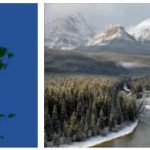North America is a continent rich in diversity, encompassing a wide range of cultures, landscapes, and economies. From the icy wilderness of Canada’s northern territories to the bustling metropolises of the United States and the tropical paradises of the Caribbean, North America offers a tapestry of nations and territories, each with its own unique identity and heritage. In this comprehensive exploration, we’ll delve into the countries and territories of North America, highlighting their geography, history, culture, and socio-economic dynamics.
1. Canada:
Canada is the second-largest country in the world by land area, known for its stunning natural landscapes, multicultural society, and high quality of life. Key features of Canada include:
- Geography: Canada is characterized by vast wilderness areas, including rugged mountains, expansive forests, and pristine lakes. The country spans six time zones and extends from the Atlantic Ocean in the east to the Pacific Ocean in the west, with the Arctic Ocean to the north.
- History: Indigenous peoples have inhabited the land now known as Canada for thousands of years, with diverse cultures and traditions. European colonization began in the 16th century, with the arrival of French and British explorers and settlers. Canada gained independence from Britain in 1867 and has since evolved into a constitutional monarchy and parliamentary democracy.
- Culture: Canada is known for its cultural diversity, with immigrants from around the world contributing to a rich tapestry of languages, cuisines, and traditions. Indigenous cultures play a significant role in Canadian society, alongside influences from French, British, and other immigrant communities.
- Economy: Canada has a highly developed economy, with key industries including natural resources (such as oil, gas, minerals, and forestry), manufacturing, technology, and services. The country is a member of the G7 group of leading industrialized nations and is known for its strong social welfare system and commitment to environmental sustainability.
2. United States:
The United States is the third-largest country in the world by land area and the most populous nation in North America, known for its economic power, cultural influence, and political prominence. Key features of the United States include:
- Geography: The United States boasts diverse geographical features, including vast plains, towering mountains, fertile valleys, and coastal regions. The country is bordered by Canada to the north, Mexico to the south, and the Atlantic and Pacific Oceans to the east and west, respectively.
- History: The United States traces its origins to the arrival of European settlers in the 17th century, with the establishment of colonies along the eastern seaboard. The American Revolution (1775-1783) led to the country’s independence from Britain, followed by westward expansion, industrialization, and the Civil War (1861-1865). The United States emerged as a global superpower in the 20th century, with significant influence in politics, economics, and culture.
- Culture: The United States is renowned for its cultural diversity, with immigrants from around the world contributing to a vibrant mosaic of languages, cuisines, and traditions. American popular culture, including music, film, literature, and sports, has had a profound impact on global trends and entertainment.
- Economy: The United States has the world’s largest economy, driven by a diverse range of industries, including finance, technology, healthcare, manufacturing, and agriculture. The country is known for its entrepreneurial spirit, innovation, and competitive business environment, attracting talent and investment from around the world.
3. Mexico:
Mexico is a vibrant and culturally rich country located in the southern part of North America, known for its ancient civilizations, colonial heritage, and modern-day traditions. Key features of Mexico include:
- Geography: Mexico is characterized by diverse landscapes, including rugged mountains, tropical forests, arid deserts, and stunning coastlines along the Pacific Ocean and the Gulf of Mexico. The country shares borders with the United States to the north and Guatemala and Belize to the south.
- History: Mexico has a rich history dating back thousands of years, with indigenous civilizations such as the Aztecs, Maya, and Zapotecs leaving behind impressive ruins and cultural legacies. Spanish conquistadors arrived in the 16th century, leading to the colonization of Mexico and the blending of indigenous and European cultures. Mexico gained independence from Spain in 1821 and has since undergone periods of political upheaval, revolution, and modernization.
- Culture: Mexico is known for its vibrant culture, colorful festivals, and diverse culinary traditions. Indigenous languages, art forms, and rituals coexist with Spanish influences, Catholic traditions, and modern-day trends. Mexican cuisine, including tacos, tamales, and mole sauces, is celebrated worldwide for its bold flavors and regional variations.
- Economy: Mexico has a mixed economy with a strong manufacturing sector, particularly in automotive, electronics, and aerospace industries. The country is also a major producer of agricultural products such as corn, beans, and avocados. Tourism plays a significant role in the Mexican economy, with popular destinations such as Cancun, Puerto Vallarta, and Mexico City attracting millions of visitors each year.
4. Caribbean Countries and Territories:
According to CountryVV, the Caribbean region comprises a diverse array of countries and territories, including island nations and overseas territories, known for their tropical climates, stunning beaches, and vibrant cultures. Some key countries and territories in the Caribbean include:
- Cuba: Cuba is the largest island in the Caribbean, known for its rich history, vibrant music, and vintage cars. The country has a socialist government and is famous for its cigars, rum, and iconic landmarks such as Havana’s colonial architecture and the beaches of Varadero.
- Jamaica: Jamaica is renowned for its reggae music, laid-back vibe, and lush landscapes. The island is home to attractions such as Dunn’s River Falls, Bob Marley’s birthplace and mausoleum, and vibrant markets selling local crafts and cuisine.
- Puerto Rico: Puerto Rico is a U.S. territory located in the northeastern Caribbean, known for its blend of Spanish and American influences, tropical rainforests, and historic sites such as San Juan’s colorful Old Town and El Yunque National Forest.
- The Bahamas: The Bahamas is an archipelago of over 700 islands and cays, famous for its crystal-clear waters, pink sand beaches, and luxury resorts. Nassau, the capital city, is known for its colonial architecture, duty-free shopping, and vibrant Junkanoo street parades.
- Other Territories: Other Caribbean territories include the Dominican Republic, Haiti, Barbados, Trinidad and Tobago, the Cayman Islands, and the British Virgin Islands, each with its own unique charm, culture, and attractions.
Conclusion:
North America is a continent of contrasts, encompassing vast expanses of wilderness, bustling cities, and tropical paradises. From the majestic landscapes of Canada and the United States to the vibrant cultures of Mexico and the Caribbean, North America offers a rich tapestry of nations and territories, each with its own unique identity and heritage. Whether exploring ancient ruins, sampling local cuisine, or soaking up the sun on a pristine beach, North America invites visitors to experience the diversity and beauty of this dynamic continent.







